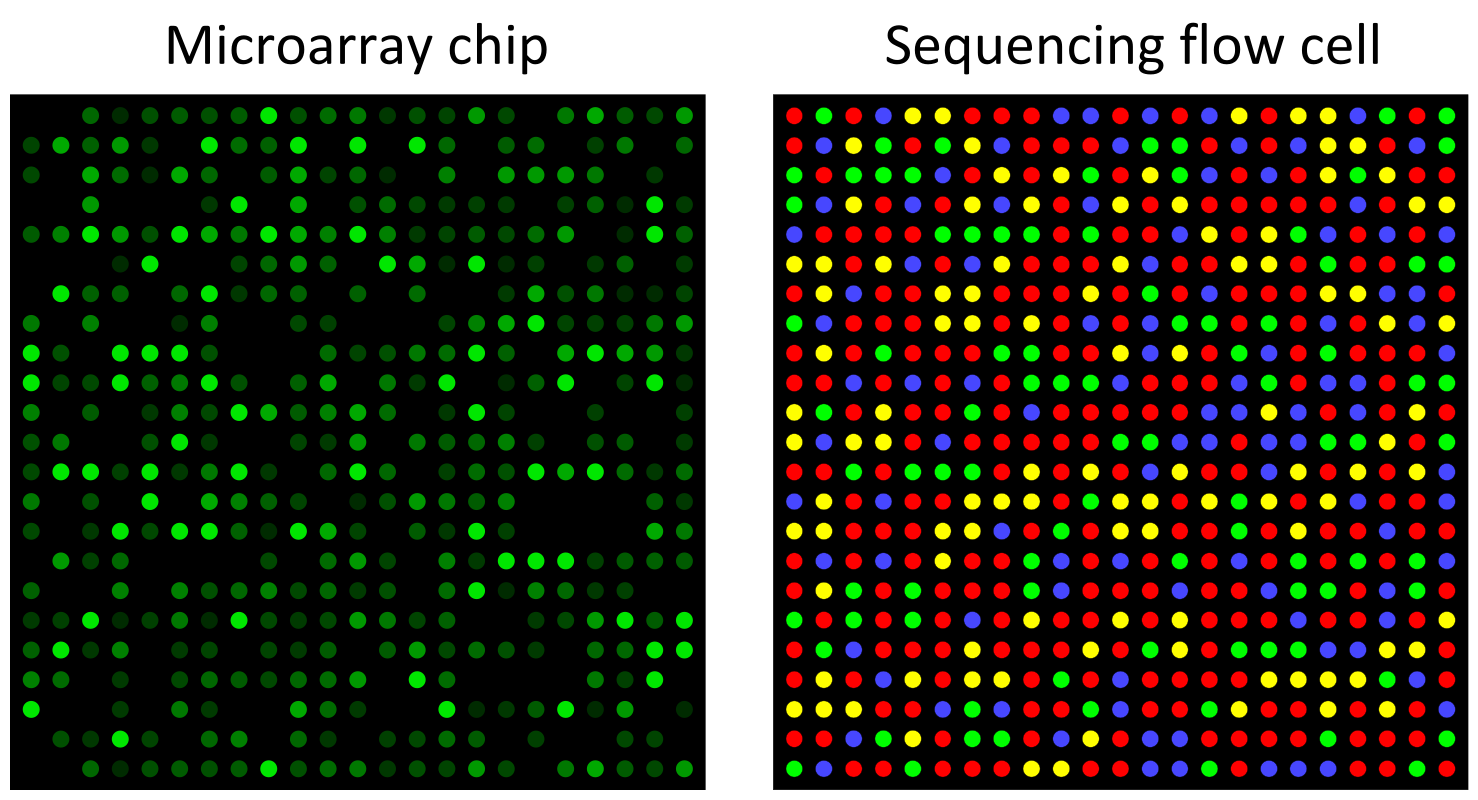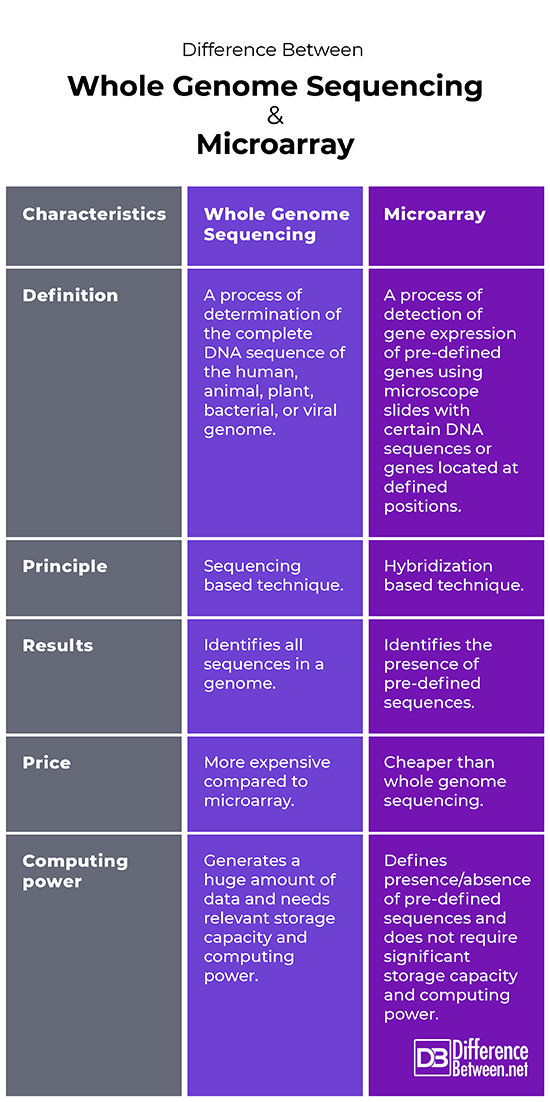Difference Between Whole Genome Sequencing and Microarray
DNA sequencing is the determination of the arrangement of the chemical building blocks called “nucleobases” throughout the DNA molecule chain. This decoding of genetic sequences shows scientists the genetic information encoded in a given DNA segment. In the double helix of DNA, each of the chemical bases always binds in the same way, to form “base pairs.” Adenine (A) always binds to thymine (T), and cytosine (C) always binds to guanine (G). This pairing underlies the mechanism by which DNA molecules are copied during cell division. Pairing is the basis of the methods used for DNA sequencing. There are different sequencing techniques, used for different purposes.
The capacity of DNA to encode genetic information is enormous – the possible number of configurations of a DNA strand consisting of n nucleotides is 4n. Depending on the purposes of the analysis it may be necessary to reveal the entire genome of an individual or only identify if certain genes are present. The process by which the complete DNA sequence of a genome is determined is called whole genome sequencing. The process of detection of gene expression of certain predefined genes using microscope slides with certain DNA sequences or genes located at defined positions is called microarray.

What is Whole Genome Sequencing?
Whole genome sequencing is the process by which the complete DNA sequence of the human, animal, plant, bacterial, or viral genome is determined simultaneously. Through whole genome sequencing, all hereditary information of a living organism is read. The result is a list with the raw nucleotide sequence of the haploid set of chromosomes. Whole genome sequencing is a powerful tool for diagnosing rare genetic diseases. However, to understand the medical or biological meaning of the obtained information, further analysis is necessary.
In 2003 the human genome was completely deciphered for the first time in an international research program launched in 1990 called the Human Genome Project (HGP). The human genome contains approximately 3 billion base pairs and is the complete set of coding “instructions” for the creation and reproduction of each organism. Whole genome sequencing generates a huge amount of data and needs relevant storage capacity and computing power.

What is Microarray?
Microarray is laboratory technology for the detection of gene expression, a peculiar library of immobilized synthetic nucleic acid samples, arranged spatially on a solid base. It uses a microscope slide with certain DNA sequences or genes located at defined positions. Using the hybridization to complementary sequences this technology helps to simultaneously profile and study the transcriptome (i.e. the set of all RNA molecules expressed in a cell).
The DNA microarray technology was developed in the mid 1990s. The basis of this technology is the hybridization between the cDNA reverse transcribed from a cell sample to a slide with an attached complementary DNA probe.
Initially, microarrays consisted of filter paper with immobilized cDNAs. Since 1995 they consist of short synthetic probes attached at specifically designated spots on the solid base (silicon or glass).
DNA microarrays are used in disease diagnosis for the detection of certain disease-relevant genes or their biomarkers. They are also used for the analysis of mutations, detection of chromosome abnormalities, screening of single nucleotide polymorphisms, and determination of posttranslational modification.
The main principle behind this method is the ability of DNA sequences to pair with complementary ones via hydrogen bonds. The high number of complementary base pairs ensures a strong bond. The non-specifically bonded sequences are washed out while the strongly bonded remain attached to the microarray.
Difference Between Whole Genome Sequencing and Microarray
Definition
Whole Genome Sequencing: Whole genome sequencing is a process of determination of the complete DNA sequence of the human, animal, plant, bacterial, or viral genome.
Microarray: The process of detection of gene expression of pre-defined genes using microscope slides with certain DNA sequences or genes located at defined positions is called microarray.
Principle
Whole Genome Sequencing: Whole genome sequencing is a sequencing based technique.
Microarray: Microarray is a hybridization based technique.
Results
Whole Genome Sequencing: Wholegenome sequencing identifies all sequences in a genome.
Microarray: Microarray identifies the presence of pre-defined sequences.
Price
Whole Genome Sequencing: Whole genome sequencing is more expensive compared to microarray.
Microarray: Microarray is cheaper than whole genome sequencing.
Computing power
Whole Genome Sequencing: Whole genome sequencing generates a huge amount of data and needs relevant storage capacity and computing power.
Microarray: Microarray defines presence/absence of pre-defined sequences and does not require significant storage capacity and computing power.
Difference between whole genome sequencing and microarray

Summary:
- Each DNA molecule is a packaged separate chromosome, and all the genetic information contained in each organism’s haploid set of chromosomes is called a genome.
- Depending on the purposes of the analysis it may be necessary to reveal the entire genome of an individual or only identify if certain genes are present.
- The process by which the complete DNA sequence of a genome is determined is called whole genome sequencing.
- The process of detection of gene expression of pre-defined genes using microscope slides with certain DNA sequences or genes located at defined positions is called microarray.
- Whole genome sequencing is a sequencing based technique, while microarray is a hybridization based technique.
- Whole genome sequencing identifies all sequences in a genome, while microarray identifies the presence of a pre-defined set of sequences.
- Whole genome sequencing is more expensive than microarray.
- Whole genome sequencing generates a huge amount of data and needs relevant storage capacity and computing power. Microarray defines presence/absence of pre-defined sequences and does not require significant storage capacity and computing power.
- Difference Between Gallstones and Cholecystitis - September 5, 2021
- Difference Between Constipation and Cramping - August 4, 2021
- Difference Between Whole Genome Sequencing and Microarray - May 6, 2021
Search DifferenceBetween.net :
Leave a Response
References :
[0]Klug, W. and M. Cummings. Concepts of Genetics (6th Edition). 1999. Print.
[1]Ordoukhanian, S., S. Phillip, R. Daniel (Eds.) Next Generation Sequencing. Methods and Protocols. Berlin: Springer Science+Business Media. 2018. Print.
[2]Stubs, M. and N. Suleyman. Cell biology and genetics. China: Elsevier. 2013. Print.
[3]Image credit: https://commons.wikimedia.org/wiki/File:Microarray_and_sequencing_flow_cell.svg
[4]Image credit: https://commons.wikimedia.org/wiki/File:Whole_genome_shotgun_sequencing_versus_Hierarchical_shotgun_sequencing.png
